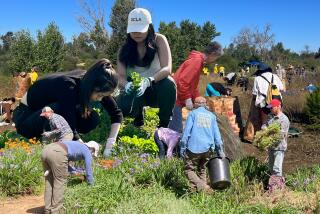Pomegranate: Tree from Iran thrives in the California sun
The first time you crack open a pomegranate, you understand why this Iranian native has achieved such significance around the world. The hard, leathery shell splits with a satisfying crack, revealing clusters of bright red seeds, juicy and glistening, sweet-sour on the tongue.
Pomegranates are mentioned in the Koran, the Bible and the Book of Exodus. Some believe the apple in the Garden of Eden was a pomegranate. In Mexico, pomegranate seeds are essential for chiles en nogada, a patriotic-colored dish served in September, around Independence Day. Chinese and Vietnamese Buddhists offer the fruit on New Year’s altars.
It can be a tree or a bush, depending on pruning, and it starts pumping out fruit after three years in the ground. The plant is deciduous and may lose its leaves while still having fruit. Pomegranate (Punica granatum) is a favorite plant for bonsai gardeners, and dwarf varieties do well in containers.
Although it flourishes in our Mediterranean climate, pomegranate needs good drainage and benefits from a hot site. (Partial shade is OK.) For relatively new transplants a few feet high, water slowly overnight and let the soil dry out a couple of weeks. Older trees are more drought tolerant. If a plant is not flowering or fruiting, cut back on the water and fertilizer. Beware of over-watering.
Pomegranates will perform better later in life -- up to 200 years -- if pruned young. Without observant clipping of branches and suckers, the plant will become a shrub rather than a tree. In both forms it will bear fruit.
Iran, where it’s the national fruit, has more than 600 named varieties. Majid Jahanbin, founder of Paradise Nursery in Chatsworth, likes the Saveh, named after the ancient city 60 miles southwest of Tehran. The Saveh doesn’t crack, the fruit are consistent in size, and the seeds aren’t as hard as the variety called Wonderful, he said.
One way to juice a whole fruit: Peel the seeds away from the inner membranes, collect them in a plastic bag, and crush with a rolling pin. Drain the accumulated juice from a torn corner of the bag.
The Global Garden, a look at our multicultural city through the lens of its landscapes, appears here on Tuesdays. For an easy way to follow future installments, join our Facebook page for Gardening in the West. Email: [email protected].






